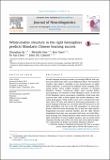| dc.contributor.author | Qi, Zhenghan | |
| dc.contributor.author | Han, Michelle | |
| dc.contributor.author | Garel, Keri-Lee A | |
| dc.contributor.author | San Chen, Ee | |
| dc.contributor.author | Gabrieli, John D. E. | |
| dc.date.accessioned | 2017-11-09T18:18:38Z | |
| dc.date.available | 2017-11-09T18:18:38Z | |
| dc.date.issued | 2014-09 | |
| dc.date.submitted | 2014-08 | |
| dc.identifier.issn | 0911-6044 | |
| dc.identifier.uri | http://hdl.handle.net/1721.1/112158 | |
| dc.description.abstract | Second language learning becomes increasingly difficult with age, but some adults learn more successfully than others. We examined whether inter-subject variability in the microstructure of white matter pathways, as measured by diffusion tensor imaging (DTI), would predict native English speakers' outcomes in learning Mandarin Chinese. Twenty-one adults were scanned before participating in an intensive 4-week Mandarin course. At the end of the Mandarin course, participants completed a final exam that assessed their skills in both spoken and written Mandarin. Individual participants' white-matter tracts were reconstructed from their native DTI data and related to final-exam performance. Superior language learning was correlated with DTI measures in the right hemisphere, but not in the left hemisphere. In particular, greater initial fractional anisotropy (FA) in both the right superior longitudinal fasciculus (parietal bundle) and the right inferior longitudinal fasciculus was associated with more successful Mandarin learning. The relation between white-matter structure in the right hemisphere of native English speakers and successful initial language learning may reflect the tonal and visuo-spatial properties, respectively, of spoken and written Mandarin Chinese. | en_US |
| dc.language.iso | en_US | |
| dc.publisher | Elsevier | en_US |
| dc.relation.isversionof | https://doi.org/10.1016/j.jneuroling.2014.08.004 | en_US |
| dc.rights | Creative Commons Attribution-NonCommercial-NoDerivs License | en_US |
| dc.rights.uri | http://creativecommons.org/licenses/by-nc-nd/3.0/ | en_US |
| dc.source | Elsevier | en_US |
| dc.title | White-matter structure in the right hemisphere predicts Mandarin Chinese learning success | en_US |
| dc.type | Article | en_US |
| dc.identifier.citation | Qi, Zhenghan et al. “White-Matter Structure in the Right Hemisphere Predicts Mandarin Chinese Learning Success.” Journal of Neurolinguistics 33 (February 2015): 14–28 © 2015 Elsevier | en_US |
| dc.contributor.department | Institute for Medical Engineering and Science | en_US |
| dc.contributor.department | Massachusetts Institute of Technology. Department of Brain and Cognitive Sciences | en_US |
| dc.contributor.department | McGovern Institute for Brain Research at MIT | en_US |
| dc.contributor.mitauthor | Qi, Zhenghan | |
| dc.contributor.mitauthor | Han, Michelle | |
| dc.contributor.mitauthor | Garel, Keri-Lee A | |
| dc.contributor.mitauthor | San Chen, Ee | |
| dc.contributor.mitauthor | Gabrieli, John D. E. | |
| dc.relation.journal | Journal of Neurolinguistics | en_US |
| dc.eprint.version | Final published version | en_US |
| dc.type.uri | http://purl.org/eprint/type/JournalArticle | en_US |
| eprint.status | http://purl.org/eprint/status/PeerReviewed | en_US |
| dspace.orderedauthors | Qi, Zhenghan; Han, Michelle; Garel, Keri; San Chen, Ee; Gabrieli, John D.E. | en_US |
| dspace.embargo.terms | N | en_US |
| dc.identifier.orcid | https://orcid.org/0000-0002-4812-8842 | |
| dc.identifier.orcid | https://orcid.org/0000-0002-9198-6535 | |
| dc.identifier.orcid | https://orcid.org/0000-0003-1158-5692 | |
| mit.license | PUBLISHER_CC | en_US |
